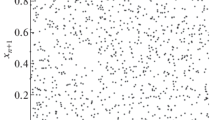Abstract
A non-linear congruential pseudo random number generator is introduced. This generator does not have the lattice structure in the distribution of tuples of consecutive pseudo random numbers which appears in the case of linear congruential generators. A theorem on the period length of sequences produced by this type of generators is proved. This theorem justifies an algorithm to determine the period length. Finally a simulation problem is described where a linear congruential generator produces completely useless results whereas good results are obtained if a non-linear congruential generator of about the same period length is applied.
Similar content being viewed by others
References
Afflerbach, L. (1983) Lineare Kongruenz-Generatoren zur Erzeugung von Pseudo-Zufallszahlen und ihre Gitterstruktur. Dissertation, TH Darmstadt
Afflerbach, L. and Grothe, H. (1985) Calculation of Minkowski-reduced lattice bases. Computing 35, 269–276.
Aigner, A. (1975) Zahlentheorie. deGruyter, Berlin-New York
Beyer, W.A. (1972) Lattice structure and reduced bases of random vectors generated by linear recurrences. In: S.R. Zaremba (Ed.) Applications of number theory to numerical analysis, 361–370
Beyer, W.A.; Roof, R.B. and Williamson, D. (1971) The lattice structure of multiplicative pseudo-random vectors. Math. Comp. 25, 345–363
Coveyou, R.R. (1969) Random number generation is too important to be left to chance. Studies in applied mathematics, SIAM III, 70–111
Dieter, U. (1975) How to calculate shortest vectors in a lattice. Math. Comp. 29, 827–833.
Dieter, U. (1979) Schwierigkeiten bei der Erzeugung gleichverteilter Zufallszahlen. Proc. in Oper. Res. 8, 249–272
Eichenauer, J. and Lehn, J. (1986) On the structure of quadratic congruential sequences, Technische Hochschule Darmstadt, Fachbereich Mathematik, Preprint Nr. 1000
Knuth, D.E. (1981) The art of computer programming, vol. 2, 2nd ed., Addison-Wesley
Knuth, D.E. (1986) Personal communication
Lehmer, D.E. (1951) Mathematical methods in large-scale computing units. Ann. Comp. Lab., Harvard Univ. 26, 141–146
Marsaglia, G. (1968) Random numbers fall mainly in the planes. Proc. Nat. Acad. Sci. 61, 25–28.
Marsaglia, G. (1970) Regularities in congruential random number generators. Numer. Math. 16, 8–10
Marsaglia, G. (1972) The structure of linear congruential sequences. In: S.K. Zaremba (Ed.) Applications of number theory to numerical analysis, 249–285
Rotenberg, A. (1960) A new pseudo-random number generator. Journ. ACM 7, 75–77
Schmitz, N. and Lehmann, F. (1985) Monte-Carlo-Methoden I, 3rd. ed. Skripten zur Mathematischen Statistik Nr. 2, Universität Münster
Author information
Authors and Affiliations
Rights and permissions
About this article
Cite this article
Eichenauer, J., Lehn, J. A non-linear congruential pseudo random number generator. Statistische Hefte 27, 315–326 (1986). https://doi.org/10.1007/BF02932576
Received:
Revised:
Issue Date:
DOI: https://doi.org/10.1007/BF02932576




